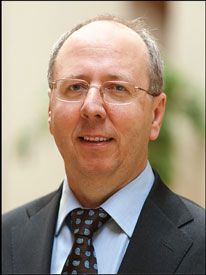Publication
Article
Oncology & Biotech News
Biomarker Identifies Patients With Advanced Lung Cancer Who Will Gain Most From Add-On Cetuximab
Author(s):
Investigators reported that high tumor EGFR expression is a predictive biomarker that defines patients with advanced NSCLC who are most likely to derive a survival benefit from the addition of cetuximab to platinum-based, first-line chemotherapy.

Robert Pirker, MD
Investigators reported that high tumor epidermal growth factor receptor (EGFR) expression is a predictive biomarker that defines patients with advanced non—small cell lung cancer (NSCLC) who are most likely to derive a survival benefit from the addition of cetuximab to platinum-based, first-line chemotherapy.
“To our knowledge, this is the first study to show that tumor EGFR expression level is associated with survival benefit for a targeted therapy given concurrently with first-line chemotherapy in patients with advanced NSCLC,” said Robert Pirker, MD, with the Medical University of Vienna in Austria, and associates.
For their study, the group examined the association of tumor EGFR expression level with clinical outcome in patients enrolled in the phase III First-Line Erbitux in Lung Cancer (FLEX) study.
They pointed out that attention has been increasingly focused on the identification of predictive tumor biomarkers in order to improve the benefit-risk ratio of anticancer treatments. Ultimately, these biomarkers can help refine the selection of patients who are likely to benefit most from treatment.
The FLEX study had already shown that patients with EGFR-expressing, advanced NSCLC who had been randomized to the EGFR inhibitor cetuximab on top of chemotherapy involving cisplatin and vinorelbine had a superior overall survival (OS) than patients assigned to chemotherapy alone (hazard ratio [HR], 0.871; 95% CI 0.762-0.996; P =.044).
In the present analysis, the researchers used an immunohistochemistry scoring system in which a score <200 indicated low EGFR expression while a score ≥200 denoted high EGFR expression.
High EGFR expression was scored for 345 (31%) of 1121 patients in whom tumor EGFR expression data were available and low EGFR expression for 776 (69%) patients.
Median OS was longer in the high EGFR expression group in the cetuximab-pluschemotherapy arm compared with the chemotherapy-alone arm (median of 12.0 mo [95% CI, 10.2-15.2] vs 9.6 mo [CI, 7.6-10.6]; HR, 0.73; CI, 0.58-0.93; P =.011).
The improved OS in the cetuximab-pluschemotherapy, high-EGFR group was achieved without an appreciable increase in side effects. There was no OS benefit in the low-EGFRexpression group (a median of 9.8 mo [CI, 8.9- 12.2] vs 10.3 mo [CI, 9.2-11.5]; HR, 0.99; CI, 0.84- 1.16; P =.88).
Extended OS in the chemotherapy-pluscetuximab group was observed for patients with high EGFR expression in all major NSCLC histological subgroups that were examined.
The authors said that the clinically meaningful improvements in survival and benefit-risk ratio in patients with high tumor EGFR expression in the diverse population of patients enrolled in the FLEX study provide a strong rationale for the use of EGFR expression in clinical practice to identify which patients with advanced NSCLC will benefit from the addition of cetuximab to first-line chemotherapy.

































%20(2)%201-Recovered-Recovered-Recovered-Recovered-Recovered-Recovered-Recovered-Recovered-Recovered-Recovered-Recovered-Recovered-Recovered-Recovered-Recovered-Recovered-Recovered.jpg?fit=crop&auto=format)
%20(2)%201-Recovered-Recovered-Recovered-Recovered-Recovered-Recovered-Recovered-Recovered-Recovered-Recovered-Recovered-Recovered-Recovered-Recovered-Recovered-Recovered-Recovered.jpg?fit=crop&auto=format)